![]()
![]()
![]()
Use LEFT and RIGHT arrow keys to navigate between flashcards;
Use UP and DOWN arrow keys to flip the card;
H to show hint;
A reads text to speech;
94 Cards in this Set
- Front
- Back
|
symbiotic associations
|
organisms of different species living together
|
|
|
Facultative symbiosis
Obligate symbiosis |
-Symbionts can exist independently of one another, both can still benefit (clown fish & sea anemone)
-one or both organisms must be together to survive (termite & organism in body) |
|
|
coevolutionary relationships
|
symbionts interact and evolve evolutionarily
|
|
|
Mutualism
|
Both symbionts benefit
>coral (oxygen, glucose)+zooxanthellae (protection, CO2, home) >ants (honeydew)+aphids(protection) >hermit crabs (protection from predators)+ sea anemones (motility) |
|
|
Parasitism
|
Parasites benefit, host is harmed
-necrotrophic= host is eventually killed by parasite -biotrophic= host lives with parasite (most parasites have evolved to be biotrophic) -ectoparasites= live outside host -endoparasites= live in hosts >flea, bed bugs >cuckoo + warbler >oyster pea crab+oyster -parasitoid= parasite lives in/on host while developing, kills host once development finishes, becomes free-living >wasp+catalpa worm (caterpillar of sphinx moth) |
|
|
Commensalism
|
One animal benefits, other neither harmed nor benefits
>Sloth+ sloth moth (eats algae on sloth fur) -phoresy= one animal uses another only for transportation >bird louse+louse fly -inquilinism= one animal uses another for housing >barnacles+whales -matabiosis= one animal takes advantage of suitable environment provided by another >hermit crab+snail shell |
|
|
Amensalism
|
one symbiont harmed, other unaffected
-competition >mussles living on a substrate with other filter feeders |
|
|
Ethology
|
study of animal behavior, especially under natural circumstances
|
|
|
Proximate Causation
|
how an animal triggers a behavior, immediate physiological causation of a behavior
|
|
|
Ultimate Causation
|
why an animal does a behavior
|
|
|
taxis
|
response to a stimulus by moving toward or away from it
-phototaxis=response due to light -thermotaxis=response to temperature -thigmotaxis=response to physical contact |
|
|
reflex
|
involuntary response to a stimulus
|
|
|
Greylag goose study
|
female sees egg out of nest, rises from nest, uses head/neck/bill to retrieve egg
-completes task in orderly fashion even if something changes, must go all the way through sequence -fixed action pattern= stereotypical behavior that is a response to a situation -releaser/sign stimulus= stimulus that initiates behavior (can produce wrong behavior) |
|
|
innate behavior
|
inherited behavior, do not have to learn behavior to survive and reproduce
|
|
|
Habituation
|
innate response to a stimulus decreases
-low intensity stimuli, non-painful >police horse in a big city |
|
|
Sensitization
|
innate response to a stimulus becomes larger than usual, increases
-high-intensity stimulus, painful and unpleasant >aquatic snail withdraw gills with electric shock |
|
|
Imprinting
|
specific to young animals, cause by exposure to certain stimuli during correct part of development
>ducklings& goslings follow first large object they see |
|
|
Societal Learning/ Learning in a Society
|
learning from a social group
>macaque washing and eating food |
|
|
Animal communication
|
used to influence behavior of another animal
-signals can be sound, odor, movement, touch, visual... |
|
|
Social behavior
|
any interaction that results from a response from one animal to another of the same species
-brief/temporary or long range >competition (food, mates, territory, any necessity) >territoriality (territory= fixed area whose occupant keeps out intruders of same species) >mating systems (monogamy= one male and one female pair up for life or breeding season, polygamy= either male or female has multiple mates) polygyny= 1 male+multiple females polyandry= 1 female+multiple males |
|
|
integument
|
protective outer-body covering, semi-permeable so it can regulate material internally/externally (water balance, temp balance)
-Inverts: epidermis (epithelium), non-cellular cuticle secreted by epidermis -Verts: epidermis (stratified squamous epithelium), dermis (dense fibrous connective tissue) |
|
|
Keratinzation
|
as epithelial cells age, they move up= take in keratin for protection, eventually shed or become removed
|
|
|
skeletal system
|
many skeletal systems are not composed of bone
function: protection, structure, movement, site of muscle attachment |
|
|
hydrostatic skeleton
|
fluid-filled cavity used for structure and movement
-fluid puts pressure on integument to give structure, allows for muscle function >earthworms, cnidaria, nematoda, sea stars |
|
|
muscular hydrostat
|
lacks bone and fluid support, muscles themselves provide support
-muscles are non-compressible >mammal tongue, elephant trunk, octopus tentacle |
|
|
rigid skeleton
|
rigid parts for muscles to attach to
-muscles work in opposing sets= extensors& flexors, muscles only pull so they need an attachment place -rigid exoskeleton= outside body, for protection & locomotion & structure, secreted by integument (will grow with animal) or integument is rigid exoskeleton (must be molted=ecdysis) >insects, inverts, molluscs, clams, crabs -rigid endoskeleton= inside body, locomotion & structure, can grow with animal, calcareous plates or bones/cartilage >sea stars, sea urchins, verts |
|
|
Bone
|
-spongy/cancellous bone= light, porous, mesh work of materials
trabecula= rod shape, form lattice work of bone where most stress is for max strength pores filled with marrow= produce erythrocytes and leukocytes (found in ends of long bones or flat bones) -compact bone= more dense, more calcium, more matricx, less porous, appears solid osteon= outer layer of all bones, most of shaft of all bones |
|
|
Muscle
|
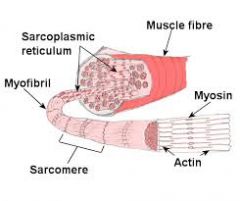
-fascicle=bundle of muscle fibers surrounded by connective tissue
-muscle fibers= cells that make up fascicle -myofibrils= make up muscle fibers, run lengthwise -sarcolemma= plasma membrane around muscle fibers, extend into cells to connect myofibrils -sarcoplasmic reticulum= mesh-like organelle surrounding myofibril, calcium storage -sarcomeres= sets of overlapping protein filaments in repeating patterns that make up myofibrils >z-lines= bands that separate each sarcomere -actin&myosin= main proteins of sarcomeres, responsible for muscle contraction >troponin&tropomyosin are secondary proteins around actin filaments |
|
|
Calcium in Muscle Function
|
calcium is released from sarcoplasmic reticulum, binds to troponin and changes its shape, confirmational (shape) change pushes tropomyosin off of resting place to reveal active sites on actin filament, club-shaped heads of myosin attach to active sites of actin and pull actin along= sarcomere shortens and muscle contracts
|
|
|
motor units
|
motor neurons + all muscle fibers/cells in innervates
-multiple motor units per muscle -more motor units recruited=more muscle force -fine muscle control (motor neurons stimulate muscle fibers to contract, stimulate movement) |
|
|
Skeletal muscle fibers
-slow oxydative -fast oxydative -fast glycolytic |
1. Slow oxydative fibers (slow twitch muscles)
-muscles that need to be active continuously -slow, sustained contraction, fatigue resistant -muscles high in these fibers= "red muscle"= highly vascularized, lots of mitochondria, ,yoglobin 2. Fast oxydative fibers (fast twitch muscles) -fast, powerful contractions -fatigue-resistand -high blood supply, lots of mitochondria, lots of myoglobin= "pink muscle" 3. Fast glycolytic fibers (fast twitch muscles) -fast, powerful contractions -fatigues easily -fibers are large in diameter=most myofibrils=most force -whitish in color=less blood supply, less mitochondria, less myoglobin (function araerobically= without oxygen) |
|
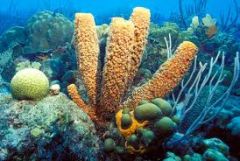
Phylum Porifera
|
"Porifera"= pore-bearing
~15000 species, mostly marine, some fresh water cessile=stay in one place suspension/ filter feeders depend on water currents for food blastula stage of development= animal classification |
|
|
Porifera body plan
|
-Cellular level organization (specialized cells to perform different body functions)
-no germ layers -no coelom (no mesoderm) -asymmetrical -no cephilization -no segmentation -neither protostome nor deuterostome |
|
|
Porifera structure
|
Pores
-ostia/ostium= incurrent pores, allow water into sponge -oscula/osculum= outcurrent pores, larger than ostia spongocoel= cavity in some sponges endoskeleton -mesh work of extracellular material=scaffolding for living cells -secreted by special cells -spicules, help provide support, protection against predators, needle-like structure (Calcium carbonate, silica) -collagen fibers= spongin mesohyl=jellylike matrix in which spicules, spongin, and cells are imbedded |
|
|
Porifera cells
|
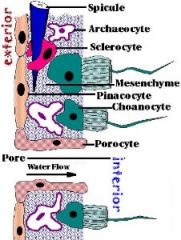
-pinacocyte= flattened cells, line external surfaces and some internal surfaces, protective function, regulate pore size
-archaeochye (amoebocyte)= amoeboid cells. move around in mesohyl, digest and distrubute food (intracellular digestion, can become any other type of cell if needed) -choanocyte (collar cell)= line canals and chambers, flagella keep water flowing through sponge, food particles stuck to microvilli of collar |
|
|
Porifera canal systems
-asconoid -syconoid -leuconoid |
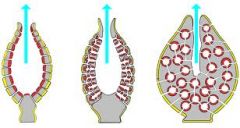
1. asconoid= simple, small, tube shape
-ostia>spongocoel>osculum 2. syconoid= tube or vase shape, thicker body -ostia>prosopyles>radial canal>apopyle>spongocoel> osculum 3. leuconoid= most common, most complex, larges, irregular shapes, no spongocoel -ostia>incurrent canal>flagellated chamber> excurrent canal> osculum |
|
|
Porifera reproduction
|
asexual
-fragmentation -budding -producing gemmules= internal buds (collegction of archaeocytes embeded in spongin of dying sponge) sexual -monoecious= male and female parts in one structure |
|

Phylum Cnidaria
|
"knide"= stinging cell
~9000 species Body Plan -Tissue level organization (no organs, beginning of nerve and muscle activity) -doploblastic (lack mesoderm) -no coelom -radial symmetry (oral-aboral axis) -no cephalization -no segmentation -neither protostome nor deuterostome |
|
|
Cnidaria:
cnidocytes |
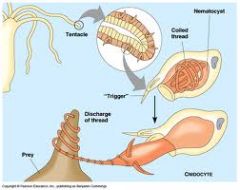
specialized cell with stinging organelle, prey capture and defense, concentrated at tentacles
-nematocyst= stinging organelle -cnidocil=trigger cilium, signals nematocyst to be released |
|
|
Cnidaria structure
|

-epidermis= outer layer, ectoderm, epitheliomuscular cells with dispersed cnidocytes and nerve cells
-gastrodermis= endoderm, nutritive-muscular cells (digestion, muscular contraction) -gastrovascular cavity= incomplete gut/blind gut (only mouth, no anus) -mesoglea= gelatinous, extracellular layer between epidermis and gastrodermis, secreted by epidermis cells, structural support -nerve function= no central nervous system= nerve net=base of epidermis and gastrodermis on either side of mesoglea, network of cells |
|
|
Cnidaria
-alternation of generations |
dimorphic= 2 different adult forms
-polyp=asexual adult, sessile, specialized roles, often fixed on substrate, reproduce by budding -medusa= motile adult, sexual reproduction, dioecious >bell/unbrella shape, body parts in 4, tentacles, floating/weak swimming >mouth at end of manubrium (stock) >produces gametes *some species have lost dimorphism and are either polyp or medusae |
|

Phylum Cnidaria
Class Hydrozoa |
Colonia
-Genus Obelia= polyp form dominates, connected by coenosarc (epidermis, mesoglea, gastrodermis, shared gvc) >perisarc=protective covering around coenosarc, made of chitin >zooid= each individual polyp, hydranth= feeding polyp, gonangium= asexual reproductive polyp= free swimming medusae Solitary -Genus Hydra= only polyp formm sexual/asexual >hypostome, basal disk/pedal disk |
|

Phylum Cnidaria
Clas Scyphozoa |
True jellyfish
-thick mesoglea, medusa form dominates, short-lived or no polyp stage |
|

Phylum Cnidaria
Class Anthozoa |
Sea anemone & coral
Largest class |
|
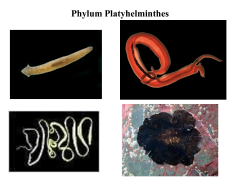
Phylum Platyhelminthes
|
"Flat worm"
~20000 species Body plan -organ level organization -triploblastic -acoelomate (mesenchyne="solid tissue layer) -bilteral symmetry (dorso-ventrally flat) -cephilization -no segmentation -protostome |
|
|
Platyhelminthes structure
|
Incomplete gut= gvc= undigested food back through mouth
Nervous system -ganglia= nerve cells in head with nerve cords running length of body Excretory system -protonephridia= tubules that excrete ammonia and maintain water balance -flame cells= flagellated cells that keep fluids moving |
|
|
Platyhelminthes reproduction
|
Sexual and/or asexual
Monoecious= hermaphroditic= male and female parts in one individual Internal fertilization |
|
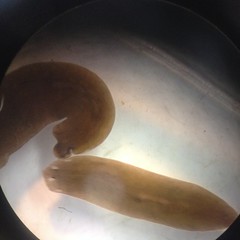
Phylum Platyhelminthes
Class Turbellaria |
Free-living flat worms
Marine, fresh-water, damp terrestrial environments Mostly carnivorous Muscular pharynx= extend out of body to seize prey Eye spot= sense light Auricles= sensing dissolved chemicals, smell >planarians |
|
|
Phylum Platyhelminthes
Class Trematoda |
Parasitic flukes
-endoparasite= live in host body (mostly vertibrates) Similar structure to turbellarians, except: -no eye spot - oral sucker -hooks to hold on to host |
|

Clonorchis sinensis
(Phylum Platyhelminthes, Class Trematoda) |
Human liver fluke
-egg shed in human waste -intermediate host: aquatic snail Eggs hatch in snail, become miracidium (motile, ciliated), travel through snail tissue to become sporocyst (loose cilia), sporocysts produce multiple redia (oral sucker, germ cell ball), redia move to snail liver and mature into cercaria -intermediate host: carp or minnow Cercaria finds fish host and burrows into muscle tissue, loose tail and encyst, cercaria becomes dormant metacercaria, fish consumed by human raw or undercooked -definitive host (where sexual reproduction occurs): human Cyst dissolved in intestine= releases fluke that moves to liver to reside |
|
|
Phylum Platyhelminthes
Class Cestoda |
Tapeworms
Endoparasites= 2 hosts Adults live in digestive tracts of vertibrates No mouth or digestive system=absorb nutrients through body wall from host -Cuticle= prevents from being digested -Proglottids= reproductive units insegments attached in chain, continuously produced behind scolex, mature as they move down chain (end of chain= gravid= full of eggs) -Scolex= unit of attachment with hooks and sucker (not a head) Self-fertilize= one proglottid fertilizes another proglottid in same tapeworm, can cross-fertilize if another present |
|
|
Taenia saginata
(Phylum Platyhelminthes, Class Cestoda) |
Beef tapeworm
Human intestine, can live as longas host Up to 10 meters -eggsshed from gravid proglottid onto ground, consumed by cows, eggs hatch in cow, larvae move into blood vessels, embed and encyst in skeletal muscle (cstercus/cysterci), developes inside-out scolex in cyst, beef consumed by human raw or undercooked ("measly beef"), move into intestine and cyst wall dissolve, scolex turns right way and attaches to intestine wall, begins producing proglottids |
|
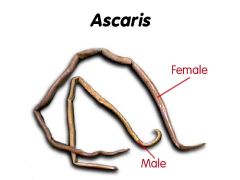
Phylum Nematoda
|
Round worms= cylindrical worms with pointed ends
"Nema"= thread Most less than 2.5mm long About 2000 known species Body plan -organ level -triploblastic -pseudocoelomate (filled with fluid to distribute nutrientsand oxygen) -bilateral symmetry -cephilization -no segmentation -protostome |
|
|
Nematoda structure
|
Complete gut= mouth and anus= digestion occurs in one way pth, specialization of gut
Cuticle= made of collagen, tough extracellular layer for protection -ecdysis= shedding/molting of cuticle when outgrown Only longitudinal muscles= can only move in thrashing motion Nervous system -ganglia -dorsal and ventral nerve cord -sensory organs clustered in head region -nerves don't have axons= muscles have cytoplasmic extensions that send message to neurons= muscle arms Each animal in each species has the exact same number of cells= eutely |
|
|
Nematoda reproduction
|
Dioecious= males generally smaller than female, males have hooked end
-copulary spicules= on hooked end of male, aid in holding on for internal fertilization Direct development -ecdysis of cuticle between stages -no true larval stage |
|
|
Nematoda life cycle
Ascris lumbricoides |
Intestineal round worms of humans (parasitic)
Adults live in small intestine & follow after food bolus (clump of food) -eggs shed in feces, eggs have tough protective shell, juvenile develop in shell -human consume soil or unclean plant material -juvenile hatch in large intestine, burrow through intestinal wall into blood stream to lungs, get coughed up and swallowed again to reach small intestine |
|
|
Nematoda life cycle
|
Soil-living= beneficial or parasitic, aid or destroy plants, can eat crop-consuming insects or other nematodes
|
|
|
Nematoda life cycle
Hook worm |
Parasitic
Common in tropics Adults up to 11mm long Prevalence in US declined by use of shoes -burrow into skin, make way to lungs, eventually make way to small intestine where they attach and suck blood (Most nematodes are harmless to people) |
|
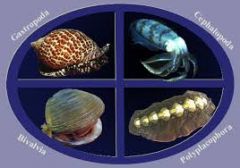
Phylum Mollusca
|
soft body
marine, fresh water, terrestrial Over 90000 species (about 70000 in fossil record) Body plan: -organ system organization -triploblastic -eucoelomate (small coelom around major organs) -bilateral symmetry -some cephalized, some not -no segmentation -protostomes |
|
|
Mollusca form and function
|
-head-foot= ventral part of animal, feeding, locomotion, sensing environment
foot= very muscular, modified for each species -visceral mass= contains most organs -complete gut -radula= feeding organ, rasping (scraping), rows of backward facing teeth made of chitin (unique to mollusks) teeth mounted on cartilage base= odontophore teeth replaced by new ones when worn out radula can be modified -mantle= 2 folds of skin that are outgrowths of the body wall, protect visceral mass -valve= shell (in some molluscs), secreted by mantle, more protection for visceral mass -ctenidia= gills in mantle cavity, often ciliated terrestrial molluscs have lungs rather than ctenidia -mantle cavity= out spot for waste and reproductive products |
|
|
Mollusca nervous system
Mollusca circulatory system |
Nervous
-multiple pairs of ganglia connected by nerve cords -sensory receptors (mechanoreceptors, chemoreceptors, statocysts, photoreceptors) >photoreceptors= ocelli (sense light vs. dark) to eyes, or none at all Circulatory: -open circulatory system= blood not always confined to blood vessels, can travel through open sinuses in body |
|
|
Mollusca reproduction
|
dioecious= separate male/female
direct and indirect development |
|

Phylum Mollusca
Class Polyplacophora |
"many plates"
>chiton dorsoventrally flattened mantle cavity runs on either side of foot -ctenidia run on both sides shell made of 8 curved plates marine (rocky intertidal zone) herbivorous= eat algae off of rocks -veiled chiton eat invertibrates |
|

Phylum Mollusca
Class Scaphopoda |
tooth/tusk shells
conical shells open at both ends, mantle fused in cone shape to inside marine (subtidal zone to depths)= burrowed into sand not commonly seen |
|
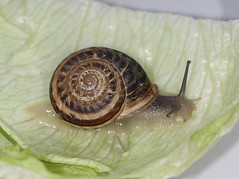
Phylum Mollusca
Class Gastropoda |
"stomach foot"
>snails, slugs, nudibranchs, abalone, limpits most are herbivores, some carnivores, some detritovores if they have shells, univalve (one shell) -some coiled, shield like size: microscopic to 1m 70000 species cephalization, most have eyes (some on eye stocks) locomotion: muscle contracts in foot pulmonate=having a lung, lost gills >snails & slugs in terrestrial and freshwater -slugs= vestigial shell (no real purpose, not evolutionarily gone) or no shell, lung in mantle highly vascularized lung= opens to pneumostome (air hole) anus opens through pneumostome partially detorted |
|
|
Phylum Mollusca
Class Gastropoda torsion |
torsion= 180 degree counterclockwise rotation of visceral mass, mantle, and mantle cavity
-occurs during larval stage -bring mantle cavity to front of animal -anus and mantle cavity open up over head (fouling= waste from anus can wash back over gills -detorsion= partial return to untorsion state -shell typically asymmetrically coiled planospiral shell= symmetrical, lined up w/ body mass conispiral shell= whorls go off to side, shifted to side (lost right ctenidium, kidney, atrium, reduce fouling) |
|
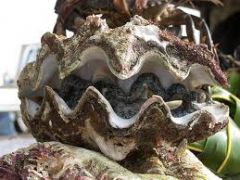
Phylum Mollusca
Class Bivalvia |
two shells
>clams, oysters, mussels, scallops, ship worms mostly marine, some fresh water no cephalization, no eyes, some have ocelli laterally compressed mantle attached to valves (shells) and drapes over visceral mass valves hinge together w/ elastic ligament, teeth hold valves into alignment, adductor muscles hold valves together filter feeders, no radula umbo= oldest part of shell food particle collected on mucus string in ctenidia to labial palps and into mouth labial palps surround mouth foot used for locomotion siphons are extensions of mantle most species are semi-sessile in adulthood -mussels used byssal threads to attach to surface |
|

Phylum Mollusca
Class Cephalopoda |
-"head-foot"
>squid, octopus, nautilus, cuttlefish -marine -largest of all inverts -smartest of inverts= largest and most complex -central nervous system -well developed cephalization -highly developed eyes -mostly predators= use tentacles to capture food, arms to hold food, beak and radula to tear up food -closed circulatory system= blood confined in blood vessels, allows for quicker gas exchange, more active lifestyle -foot modified to form arms, tentacles, funnel (used for expelling water and waste) -mantle= enclosed visceral mass -reduce or absent shell, sometimes enclosed pen= rudimentary shell (squid) |
|
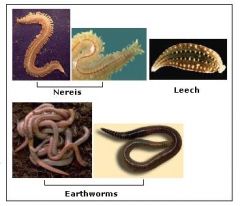
Phylum Annelida
|
segmented worms
>earthworms, leeches, marine worms mostly marine, some freshwater and terrestrial 15000 species Body plan -organ system -triploblastic -eucoelomate -bilateral symmetry -cephalized -segmentation -protostome complete gut coelom functions as hydrostatic skeleton setae= bristles/hairs, locomotion, holding onto walls of burrows two-part head -prostomium= eyes, tentacles, palps -peristomium= bigger segment around the mouth |
|
|
Annelida segmentation
|
metamerism= serial repetition of similar body parts along length of body
-allows for finer control of movement, more efficient movement, protection against injury -segments= metameres, somites separated externally (rings= annuli) internal separation= septa= divide coelom into compartments, composed of peritoneum (epithelial tissue)=lines inner body wall of each compartment, lines organs, septum formed where 2 layers of peritoneum meet |
|
|
Annelida systems
|
Nervous
-ventral nerve cord= runs length of body -fused ganglia in each metamere -brain= pair of cerebral ganglia -sensory organs concentrated in head ocelli, chemoreceptors, statocysts Respiration -cutaneous respiration= gas exchange across body wall and cuticle -a few aquatic taxa have gills Closed Circulatory system -may have multiple hearts= aortic arches Excretory system -system of paired nephridia in metameres open to outside by nephridia collect waste from blood and coelom |
|

Phylum Annelida
Class Polychaeta |
-"many hairs"
-marine animals -includes most annelids -parapodia= lateral paired appendages, setae covered, locomotion, gas exchange -acicula= rods that give structure to parapodia, made of chitin -errant polychaetes predatious, active, everted jaws on pharynx to capture prey -sedentary polychaetes live in burrows or tubes they make in substrate, filter-feeders, don't move a lot extend tentacles out of burrows or filter out of tube -reproduction dioecious no permanent gonads, temporary swellings that appear during mating season can sometimes asexually reproduce |
|

Phylum Annelida
Class Oligochaeta |
-"few hairs"= few setae
-mostly terrestrial or freshwater >includes earthworms -scavengers -reproduction monoecious, hermaphorditic mutual cross-fertilization seminal vesicle= where worm makes sperm seminal receptacles= where worm receives sperm from mating partners clitellum= reproductive structure (smooth band) made of specialized epidermal cells that secrete muscle direct development can also asexually reproduce= fission |
|

Phylum Annelida
Class Hirudinida |
>leeches, two smaller groups
mostly freshwater Hirudinea= leeches no parapodia, no setae= not haired somewhat dorsoventrally flattened dorsal and ventral suckers (front for feeding, back for holding on) 34 segments -secondary annuli= don't correspond to septa division fluid feeders -smaller inverts, blood (sanguivorous) sanguivorous leeches inject anticoagulant reproduction -monoecious -clitellum only visible during mating season -similar to oligochaetes |
|
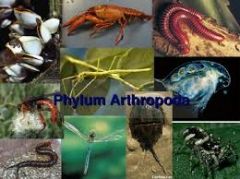
Phylum Arthropoda
|
"jointed foot"
>crustaceans, spiders, insects, etc. most diverse, successful, widespread, abundant phylum -1100000 species marine, freshwater, terrestrial only flying inverts carnivores, herbivores, detritivores, omnivores Body Plan: -organ system -triploblastic -eucoelomate (reduced coelom) -bilateral symmetry -well-developed cephalization -well-developed segmentation -protostome |
|
|
Arthropoda strucure
|
segmentation
-no septa between segments -segments=somites -tagmata (tagma)= distinct body regions made up of somites w/ individual functions exoskeleton= rigid or semi-rigid cuticle secreted by spidermis -cuticle made of multiple layers that are sclerotized (hardened), made up of chitin and protein and sometimes calcium salts and waxes -exoskeleton cannot grow with animals= ecdysis -protection, muscle attachment, shape/structure to body, maintain water balance -jointed appendages= locomotion, food handling, sensory function, defense or offense uniramous= one branch end biramous= two branch end |
|
|
Arthropoda systems
|
Nervous
-dorsal brain w/ ventral nerve cord -ganglia in segments -sensory organs ocelli to compound eyes mechanoreceptors, chemoreceptors, statocysts auditory organs complete gut open circulatory system -hemocoel= open sinuses where blood can pool -dorsal heart hemolymph= blood reproduction -most are dioecious -most do sexual reproduction -parthenogenesis= virgin birth, some females can produce offspring without male, genetically identical offspring -direct or indirect development |
|
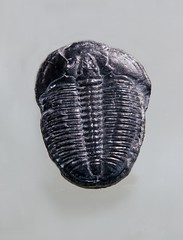
Phylum Arthropoda
Subphylum Trilobita |
-extinct
-marine, bottom dwellers on substrate -size: 2 cm to 67 cm long -scavengers -dorsoventrally flattened, 3 lobed body plan -tagmata: head (anterior), trunk, pygidium (posterior) -biramous appendagers, 1 pair antennae legs on all segments except last segment -mouth parts= hypostome |
|
|
Phylum Arthropoda
Subphylum Chelicerata |
>spiders, ticks, mites, scorpions, horseshoe crabs, sea spiders
-mostly terrestrial, some marine -tagmata cephalothorax (head & chest)= legs abdomen -uniramous appendages, no antennae, 4 pairs walking legs -highly modified mouth parts chelicerae= closest to mouth, first pair of appendages, usually fangs pedipalps= outside chelicerae, food manipulation, touch |
|
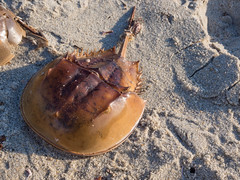
Phylum Arthropoda
Subphylum Chelicerata Class Merostoma |
>horseshoe crabs
-marine animals -ancient, only 4 species still extant -predators of small inverts, nocturnal -chelicerae and walking legs used to cease prey, pedipalps used as walking legs -carapace= hard cover of cephalothorax -ocelli on front, compound eyes on side -respiration through book gills |
|

Phylum Arthropoda
Subphylum Chelicerata Class Arachnida |
>spiders, scorpions, ticks, mites, harvestmen
-terrestrial -respiration through book lungs -mostly free living, some parasites -mostly predators -chelicerae and pedipalps modified spiders= chelicerae have fangs to inject venom, pedipalps have sensory function, males use pedipalps for sperm transfer scorpions= chelicerae for shredding food, pedipalps modified into claws for ceasing prey |
|
|
Phylum Arthropoda
Subphylum Myriapoda |
>centipedes, millipedes
-lots of parts -all terrestrial -tagmata: head, trunk (repeated segments) -uniramous appendages, 1 pair antennae, 5+ pairs walking legs -mouth parts= paired mandibles for chewing -respiration through system of tracheae= tracheal system system of tubes throughout body open to outside through holes= spiracles |
|

Phylum Arthropoda
Subphylum Myriapoda Class Chilopoda |
>centipedes
-predators= active, fast moving -venomous -dorsoventrally flattened -varying number of segments, depends on species -1 pair spiracles per segment= one on each side -1 pair legs per segment first segment has venom claws instead of legs, last 2 segments lack leggs |
|
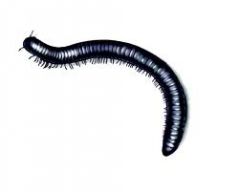
Phylum Arthropoda
Subphylum Myriapoda Class Diplopoda |
>millipedes
-detritovores, herbivores -slow moving, coil up for protection -secrete toxins out of side of body repugnatorial glands= where toxins secreted out of -round, cylindrical body -varying number of segments -2 pairs spiracles & 2 pairs walking legs per segment |
|

Phylum Arthropoda
Subphylum Crustacea |
second most speciose
crusta= "shell" mostly marine, some terrestrial & freshwater tagmata: -cephalothorax, abdomen biramous appendages, often 5 pairs walking legs, 2 pairs antennae, 2 paired chewing madibles modified appendages -mouth parts antennules, antennae= sensory function maxillae= hold food maxillipeds= holding/manipulating food mandibles= chewing -chelipeds= grasping food, defense (big claws on end= chela) -walking legs= walking, crawling -swimmerets= swimming males: copulatory swimmerets= sperm transfer -uropods= part of tail, locomotion, direction female: used to protect eggs respiration= gills -smaller crustaceans= gas exchange across thinner areas of cuticle excretory system= antennal gland/green gland, gills, or across thinner areas of cuticle -antennal gland=excretory functions, water balance |
|
|
Phylum Arthropoda
Subphylum Hexapoda |
-six leg animals
-mostly terrestrial, some freshwater -tagmata head, thorax, abdomen -uniramous appendages, 1 pair antennae, 3 pairs walking legs, mandibles for chewing |
|
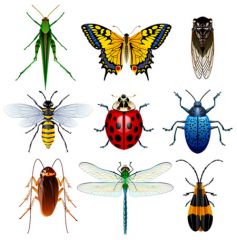
Phylum Arthropoda
Subphylum Hexapoda Class Insecta |
ecologically, economically, medically important
found almost anywhere except in oceans free-living & parasitic eat everything small size, wings, high adaptability, no competition (intraspecific competition) between larvae and adults= allow for wide distribution wings -2 pairs as adults (larvae have none), not appendages -true flies have 1 pair, second pair modified into haltere= functions as gyroscope= balance, orientation -some species have lost wings entirely (fleas, lice) excretory system -malpighian tubules=set of tiny tubes w/ ends in hemocoeal to filter out wastes respiration= tracheal system reproduction -dioecious -sexual reproduction -metamorphasis= extreme morphological changes from egg to adult instars= developmental stage between molts (2-20 instars, depends on species, environment) |
|
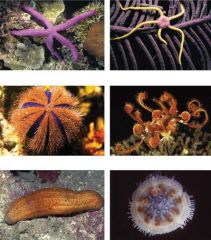
Phylum Echinodermata
|
"spiney skin"
>sea stars, sea urchins, sand dollars, etc. all marine ancient and highly derived Body plan: -organ system -triploblastic -eocoelomate -pentaradial symmetry (larvae= bilateral) -no cephalization -no segmentation -deuterostome (anus forms fist) complete gut open circulatory system most closely related to chordata oral-aboral axis (oral=bottom, aboral=top) no brain, decentralized nervous system -nerve ring w/ nerves radiating out into each arm -not well developed sensory receptors reproduction -dioecious -indirect development larval stage has bilateral symmetry |
|
|
Echinodermata structure
|
Water-vascular system
-locomotion, gathering food, excretion, gas exchange -system of canals filled with sea water throughout animal -madreporite= large pore in which water enters -stone canal -ring canal= circles central disk -radial canals= radiate from each arm -lateral canals= extensions off of radial canals, connect rest of system to tube feet -ampulla= sacs attached to tube feet, regulates water pressure in tube foot ampulla filled with water can contract and fill tube feet for use Endoskeleton -calcareous plates= dermal ossicles=plates made of calcium carbonate, embedded in skin, covered in epidermis -movable spines= defense, locomotion -pedicellaria= defense, protrude through space between dermal ossicles, pincers, remove debris from aboral surface -dermal branchia= protrude through space between dermal ossicles, skin gills, used for respiration -tube feet= locomotion, respiration ambulacra=grooves in which tube feet are found |
|

Phylum Echinodermata
Class Asteroidea |
>sea stars, sun stars
-5 or more arms connected to central disk -mouth on oral surface to substrate, anus at top -dermal ossicles= loosely bound, gaps between plates -predators, scavengers, will eat any slow-moving invert bivalves, sea urchins -regeneration= if looses arm, it can grow a new one lost arm can grow new sea star if enough of disk remains |
|
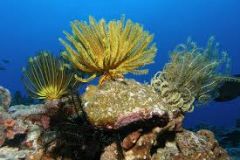
Phylum Echinodermata
Class Crinoidea |
>sea lilies, feather stars
-sessile= stock w/ attachment to substrate, occasionally motile -filter feeders -5 arms with branches -upper surface= oral surface mouth and anus on oral surface -water vascular system has coelomic fluid instead of sea water -dermal ossicles articulate with each other, closer together |
|
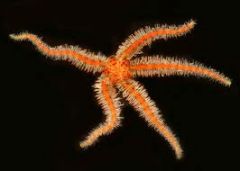
Phylum Echinodermata
Class Ophiuroidea |
>brittle stars, serpent stars, basket stars
-"serpent tailed" -predators, scavengers, filter-feeders -5 arms= thinner and distinct from central disk use arms for locomotion instead of tube feet -oral surface faces substrate (down) mouth and madreporite on oral surface, no anus -dermal ossicles articulate closely with each other -regeneration= can cast off arm to escape predator -reproduction= sexual (asexual= can cleave disk in half) |
|

Phylum Echinodermata
Class Echinoidea |
>sea urchins, sand dollars, heart urchins
-"spiney" -herbivores, some scavengers often preyed on by other echinoderms -fused or tightly joined dermal ossicles= form a shell= test (under thin layer of epidermis) -no arms, still pentamerous plan -Aristotle's lantern= 5 part jaw structure |
|
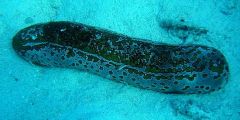
Phylum Echinodermata
Class Holothuroidea |
>sea cucumbers
-mostly filter feeders, few detritovores -reduced dermal ossicles -elongated oral-aboral axis= parallel to substrate mound on oral surface with tentacles (modified tube feet) anus on aboral surface -sole= surface that rests on substrate 3 ambulacra on sole, 2 on top -autonomous evisceration when disturbed, they go through strong muscular contractions the expel guts, used to escape predators |

